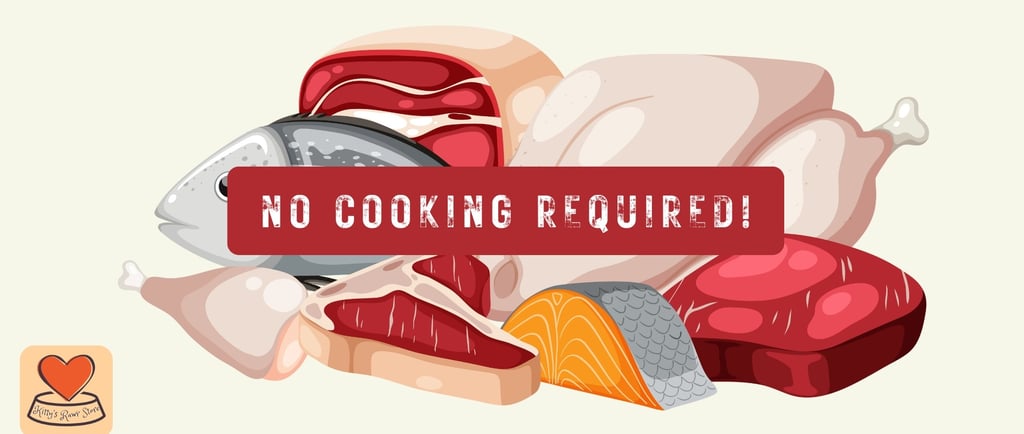Is Raw Feeding Really Necessary?
An exploration into why raw feeding is the most natural way to feed your cats and the added health benefits it can provide.


Whether you are new to raw feeding pets or have been doing it for years, there is no doubt that there is a tonne of information about it on the internet. When you search for the term "Raw feeding for cats," the very first words you will probably read will include "Cats are Obligate Carnivores." But what does that actually mean? Literally speaking it simply means "obligated to eat meat."
We all know what a Herbivore, Carnivore and Omnivore is, but an Obligate Carnivore is in a league of its own.
Obligate Carnivores must consume a regular diet of meat to survive. Their body's digestive system simply doesn't have a good enough capability of extracting nutrients from plant products. Their whole system is designed to process one type of food - meat.
All felines big and small are classed as an Obligate Carnivore, or if you want to get really fancy - a Hypercarnivore - which means it has to have at least 70% meat in its diet to survive! But now the term has been explained, what does this mean with regards to feeding raw or cooked meat?
Cat ancestry has been traced back to roughly 10-12 million years ago on Earth, and since cats appeared on this planet they have only ever eaten other animals. They are born hunters and pre-programmed predators, chasing down a live rabbit is much more natural and rewarding then sneaking up on a potato! With this in mind, the biology of their digestive system hasn't really changed that much from 10 million years ago. We may all be cat keepers at some point, but cats haven't been truly domesticated, this means that humans haven't had any significant impact on changing feline behaviour and basic biology. So, believe it or not, that happy, cute little kitty in your house is still considered a predator.
With the cat owners of today becoming more aware of this biological fact, they are returning to these ancient, core feeding practices for the benefit of their furry companions. Cat owners cherish the companionship their cats offer and want to do what they can to return that love and care by feeding what's right for them. Whilst we have to draw the line at providing a live rabbit or chicken for our cats to quell their whole range of predatory urges, we can do the next best thing and feed them a diet of raw, high-quality meat (pre-killed and prepared for them)
Providing them with a regular diet of raw meat will perfectly meet the nutritional needs of their body.
Cats are designed to metabolise high levels of meat protein and a well balanced raw diet provides them with all the required vitamins, healthy fats and essential amino acids that their body's cannot produce on their own. Cooking or processing raw meat will destroy these delicious, beneficial nutrients, which is why manufacturers of low quality dry & wet cat foods will often add artificial additives, useless carbohydrates and harmful sugars to bulk out their food and to make it more palatable. A meat protein source is what gives cats their energy, helps them maintain a healthy immune system, helps young kittens develop healthy organs and will help you out by reducing the amount of waste product found in the litter tray.
All complete raw cat food will contain a balance of ground muscle meat, bone and organs, all of these components together form the basic structure of a cats diet. Of course you can add special treats such as chicken necks, duck wings even whole day old chicks, but if you don't want to deal with a day old chick being batted around the living room floor, finding a good quality, pre-prepared complete cat food takes the fuss out of raw feeding.
A topic that normally always follows raw feeding in both dogs and cats is bacterial concerns. Of course raw pet food could carry bacteria, but applying common sense, so could human raw meat. So use common sense when handling your pets raw food - thoroughly wash hands, utensils, surfaces and store the product appropriately. Cats (and dogs) have a much more acidic stomach compared to humans, which kills bacteria that enters with food, they also have a much shorter digestive system compared to us and can fully digest and process food within roughly 12 hours compared to humans 36 - 48 hours. As well as this highly acidic stomach being designed to kill any nasty bugs which may be present, it can also perfectly break down the bone content in food so don't be concerned with feeding your cat (or dog) raw bones either minced in their food or in complete form such as wings, necks etc.
The digestive system of felines simply isn't a hospitable environment for bacteria to thrive, therefore, cats becoming ill from bacteria found in their food is very unlikely.
If you are in any doubt, I would suggest talking to a holistic vet or pet nutritionist about raw feeding rather than a 'normal' vet as holistic vets tend to be nutritionally trained whereas, in my experience, 'normal' vets are not. Alternatively, most of the brands that we stock at Kitty's Rawr Store have trained nutritionists on hand to answer any questions. Just head to their websites for contact details.
Need further advice?
Try our Advice Page for quick hints to help your furry feline. Or drop us a question via our contact form on the 'Contact Us' page and we will try our best to get you answers.


